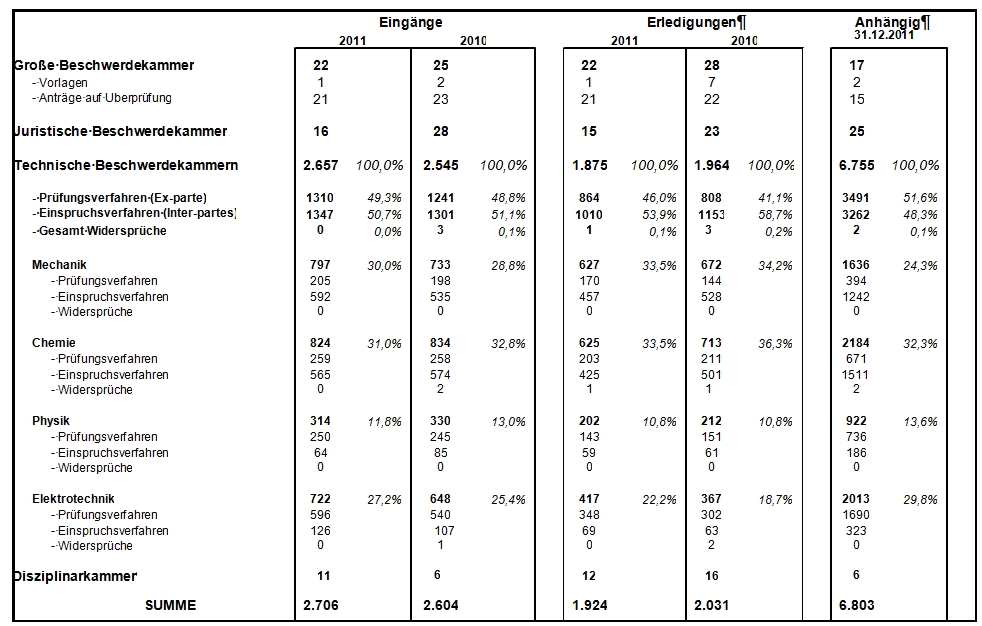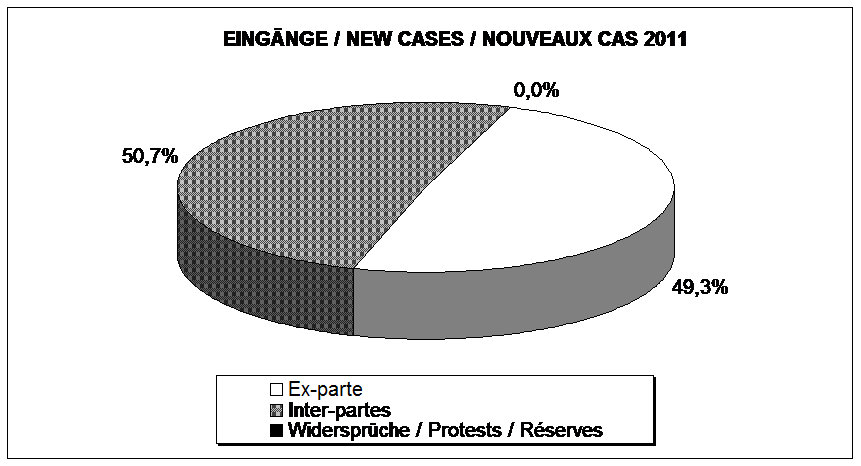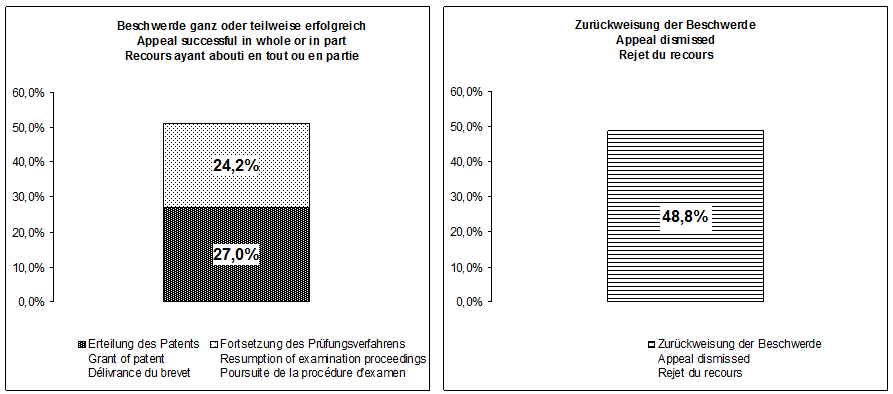BOARDS OF APPEAL
Information from the Boards of Appeal of the EPO
BOARD OF APPEAL AND ENLARGED BOARD OF APPEAL CASE LAW 2011 - PART I - BOARDS OF APPEAL ACTIVITIES IN 2011
1. Introduction
For statistics on the appeal procedure in 2011, see the tables in Section 2 below, together with the further information given in Section 3. General developments in Directorate-General 3, and the information products available, are described in Sections 4 to 6. For the boards' case law in 2011 see Part II below. In order to show the case law of the boards of appeal in 2011 as completely as possible, decisions from 2011 which were reported in last year's special edition, have again been included in the present issue. A number of important decisions from the first half of 2012 have also been taken into consideration.
2. Statistics
2.1 General statistics







2.2 Situation of the boards of appeal in the last 5 years
| New Cases | Settled | ||||||||
|---|---|---|---|---|---|---|---|---|---|---|
2011 |
2010 |
2009 |
2008 |
2007 |
2011 |
2010 |
2009 |
2008 |
2007 |
|
Legal Board of Appeal |
16 |
28 |
20 |
18 |
15 |
15 |
23 |
21 |
13 |
21 |
Technical boards of appeal |
2.657 |
2.545 |
2.484 |
2.409 |
2.090 |
1.875 |
1.964 |
1.918 |
1.782 |
1.661 |
Enlarged Board of Appeal |
|
|
|
|
|
|
|
|
|
|
Referrals |
1 |
2 |
1 |
4 |
2 |
1 |
7 |
0 |
1 |
3 |
Petitions for review |
21 |
23 |
21 |
11 |
|
21 |
22 |
16 |
3 |
|
Disciplinary Board of Appeal |
11 |
6 |
17 |
28 |
46 |
12 |
16 |
24 |
50 |
17 |
3. More about the boards' activities
3.1 Proceedings before the Enlarged Board of Appeal
3.1.1 Referrals to the Enlarged Board of Appeal under Article 112 EPC
In 2011 there was one new referral to the Enlarged Board of Appeal (2010: 2); one decision was issued (2010: 7).
In G 2/10 (OJ EPO 2012, 376), the Enlarged Board had to decide whether a disclaimer infringes Article 123(2) EPC if its subject-matter was disclosed as an embodiment of the invention in the application as filed. It held that an amendment to a claim by the introduction of a disclaimer disclaiming from it subject-matter disclosed in the application as filed infringes Article 123(2) EPC if the subject-matter remaining in the claim after the introduction of the disclaimer is not, be it explicitly or implicitly, directly and unambiguously disclosed to the skilled person using common general knowledge, in the application as filed. Determining whether or not that is the case requires a technical assessment of the overall technical circumstances of the individual case under consideration, taking into account the nature and extent of the disclosure in the application as filed, the nature and extent of the disclaimed subject-matter and its relationship with the subject-matter remaining in the claim after the amendment.
At the date of publication, three referrals were pending before the Enlarged Board of Appeal.
G 1/10 is concerned with the procedural issue of whether the patent proprietor's request for correction of the grant decision under Rule 140 EPC, which was filed after the initiation of opposition proceeding is an admissible remedy on which only the examining division has the power to take a binding decision.
In J 21/09, the Legal Board of Appeal has asked the Enlarged Board of Appeal whether a technical board of appeal or the Legal Board of Appeal is competent to hear an appeal against an examining division's decision – taken separately from its decision granting a patent or refusing the application – not to refund search fees under Rule 64(2) EPC. The case is pending as G 1/11.
G 1/12 concerns the following procedural issue: When a notice of appeal, in compliance with Rule 99(1)(a) EPC, contains the name and the address of the appellant as provided in Rule 41(2)(c) EPC and it is alleged that the identification is wrong due to an error, the true intention having been to file on behalf of the legal person which should have filed the appeal, is a request for substituting this other legal or natural person admissible as a remedy to "deficiencies" provided by Rule 101(2) EPC?
3.1.2 Petition for review under Article 112a EPC
Article 112a EPC allows parties adversely affected by a decision of the boards of appeal to file a petition for review by the Enlarged Board on the grounds that a fundamental procedural defect occurred in the appeal proceedings or that a criminal act may have had an impact on the decision. In 2011, 21 petitions were brought to a conclusion. At the time of writing, there were 14 petitions for review pending before the Enlarged Board of Appeal.
3.2 Outcome of proceedings before the technical boards of appeal
59% of ex parte cases were settled after substantive legal review, i.e. not terminated through rejection as inadmissible, withdrawal of the appeal or application, or the like. The outcome of these 512 cases was as follows:
- appeal successful in whole or in part: 262 cases (51.2%)
- grant of patent ordered: 138 cases (27.0%)
- resumption of examination proceedings ordered: 124 cases (24.2%)
- appeal dismissed: 250 cases (48.8%).
Ex parte cases settled after substantive legal review

Of inter partes cases, 69% were settled after substantive legal review. The outcome of these 699 cases was as follows (no distinction is drawn between appeals by patentees and appeals by opponents):
- appeal successful in whole or in part: 403 cases (57.7 %), ending in
- maintenance of patent as granted: 17 cases (2.4 %),
- maintenance of patent in amended form: 150 cases (21.5 %),
- revocation of patent: 169 cases (24.2 %) and
- resumption of opposition proceedings: 67 cases (9.6 %).
- appeal dismissed: 296 cases (42.3 %).
Inter partes cases settled after substantive legal review

3.3 Proceedings before the Disciplinary Board of Appeal
3.3.1 New cases 2011
- re European qualifying examination: 2 cases
- re professional representatives' code of conduct: 9 cases
3.3.2 Cases settled 2011
- re European qualifying examination: 9 cases
- re professional representatives' code of conduct: 3 cases
3.3.3 Cases pending 2011
- re European qualifying examination: 0 cases
- re professional representatives' code of conduct: 6 cases
3.4 Length of proceedings
The average length of technical proceedings was 28 months (ex parte: 29 months; inter partes: 27 months).
The number of cases pending for over two years at the end of the year under review (31.12.2011) – i.e. filed in 2009 or earlier – is as follows: 2002: 1; 2004: 1; 2005: 3; 2006: 20; 2007: 105, 2008: 637; 2009: 1 471 (in total: 2 238).
3.5 Breakdown of appeals and oral proceedings by language
The language used in appeal proceedings and protests filed in 2011 was as follows: English 72%, German 23% and French 5%.
A total of 1 166 oral proceedings took place in 2011, with the following language breakdown: English 65.6%, German 28.2% and French 6.2%.
4. Contacts with national courts, applicants and representatives
The annual MSBA meeting between members of the boards of appeal and SACEPO representatives was held on 14 October 2011.
The boards of appeal received a number of high-level visitors from contracting and non-contracting states. Representatives of DG 3 also attended various seminars and conferences as speakers.
5. Developments in DG 3
2011 saw a change at the helm of DG 3, with its Vice-President Peter Messerli retiring after almost 15 years in office. His successor as both Vice-President and chairman of the Enlarged Board of Appeal is Wim van der Eijk, whose appointment by the Administrative Council of the European Patent Organisation took effect on 1 December 2011. He was formerly Principal Director Patent Law and Multilateral Affairs, a position he had held since 2005. He also acted as Vice-President DG 5 Legal and International Affairs in 2009 and 2010.
One of Mr Van der Eijk's main priorities in his new role will be to address the increasing gap between incoming and settled appeals. To this end, measures are being considered which may have a beneficial effect on procedural efficiency and case management, as well as recruitment and improved support for the boards of appeal.
6. Number of staff and distribution of responsibilities
On 31 December 2011, there were 157 board of appeal chairmen and members (2010: 155). The 101 technically qualified and 28 legally qualified members were divided amongst 27 technical and one legal board.
The composition of each board is published in the EPO Official Journal (Supplement to OJ EPO 1; Rule 12(4) EPC). Amendments to the business distribution scheme are published on the EPO's website.
The total number of DG 3 staff was 224 on 31 December 2011 (220 on 31 December 2010).
7. Information on recent board of appeal case law
DG 3's efforts to develop information tools for providing information on board of appeal case law to the public are continuing. All the decisions handed down since 1980 are available free of charge on the EPO's website (www.epo.org). They can be accessed via the reference number or via search terms. They are also available on the ESPACE® LEGAL DVD, which is published twice a year.
In December 2011, a new special edition of the Official Journal, entitled "Case Law from the Contracting States to the EPC", was published as successor to the old European National Patent Decisions Report (first published in 2004). It contains summaries of interesting decisions handed down by the courts of the contracting states to the EPC between 2004 and 2011, providing a valuable overview of European national case law on substantive patent law issues in the three official languages of the EPO.
The sixth edition of the "Case Law of the Boards of Appeal of the European Patent Office", a comprehensive survey of all the case law of the boards of appeal in the three languages, was published in July 2010.
"Information from DG 3 Appeals", a collection comprising the boards' rules of procedure and other texts of importance for appeal proceedings, was published as a supplement to OJ EPO 1/2012.
These DG 3 publications are available from the EPO sub-office in Vienna.